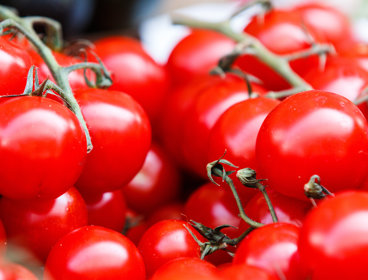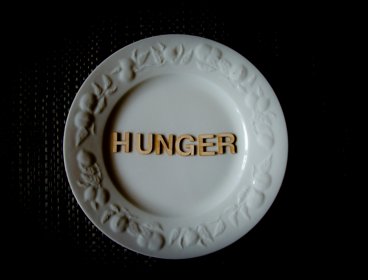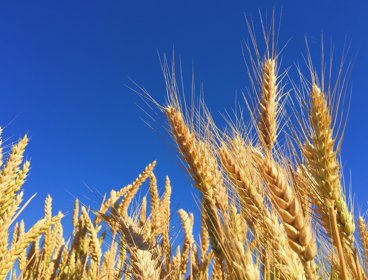July 2008
Arguably one of the most important geography in the news stories of 2008 is “The Food Crisis”, because it has already touched so many people’s lives.
Global food prices are being driven upwards by a series of inter-connected factors.
Population growth, rising affluence, energy policy and climate change – these are the “four corners” of the food crisis, a serious state of affairs leading to escalating prices and a growing shortage of food for many of the world’s poorest people.
Four corners of the food crisis
The World Bank estimates food prices have on average risen by 83% over three years. The price of rice – a staple for billions of people - has risen by three-quarters over the past year, that of wheat by 130%.
In Bangladesh, 50,000 households need emergency food aid following the rice price rise. China has put price controls on cooking oil, grain, meat, milk and eggs while in the UK, the price of pasta has risen by 80%.
There have been protests against high prices in Guinea, Egypt, Morocco, Uzbekistan, Yemen, Burkina Faso, Mauritania, Niger, Uzbekistan, Senegal, Haiti, Bolivia and Indonesia.
How can all of this be explained? It must be stressed at the outset that the causes are complex and are not simply due to changes in crop yields. On the contrary, at 2.1 billion tonnes, the global grain harvest broke all records last year - it beat the previous year's by almost 5%. “There is plenty of food. It is just not reaching human stomachs. Of the 2.13bn tonnes likely to be consumed this year, only 1.01bn, according to the United Nation's Food and Agriculture Organisation, will feed people.” (The Guardian, 15 April 2008). In fact, there are four key factors to consider, summarised in Figure 1.
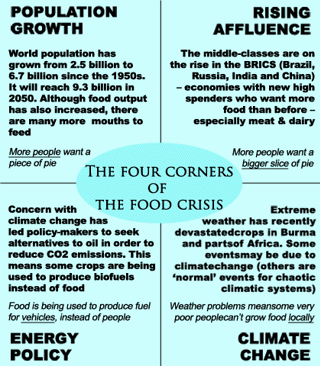
-
Population growth and change With world population growing at 78 million a year, there are always more mouths to feed. By mid-century, numbers will reach nine billion. But this in itself is not enough to explain a food shortage as crop production is also growing – for instance, according to the World Bank, global maize production grew by 51 million tonnes between 2004 and 2007. However, much of this gain was soaked up by other crop uses, mainly increased dairy and meat production along with biofuel manufacture.
-
Rising affluence (increased meat and dairy demands) Growing numbers of people want more food than they used to, especially meat and dairy products. As a result, 760 million tonnes of grain will be used to feed animals - which could cover the global food deficit 14 times (The Guardian, 15 April 2008). “If you care about hunger,” says one Guardian journalist, “eat less meat.”
Thanks to the inefficient way food chains work, animals use up a lot of converted biomass energy roaming around, defecating and respiring. Beef cattle eat about eight kilograms of grain or meal for every kilogram of flesh they produce; a kilogram of battery-reared chicken needs just two kilograms of feed (but this introduces new ethical concerns). With meat consumption starting to take-off in the BRICS (Brazil Russia China and India), less grains and cereals are left to be sold as food on global markets to people in poorer nations.
UK government new chief scientific adviser Professor John Beddington explains that development and increasing wealth are adding to the food crisis. “Once you move to [an income of] between £1 a day and £5 a day you get an increase in demand for meat and dairy products ... and that generates a demand for additional grain.” (The Guardian, 07 March 2008).
About 2.7 billion people in the world currently live on less than £1 a day. As more of them are lifted out of poverty, as seems to be occurring in Asia and South America, grain demand can be expected to rise steeply to meet the expanding needs of meat producers. At present there are just 350 million households worldwide living on £8,000 a year. That is projected to increase to 2.1 billion by 2030 (The Guardian, 07 March 2008). On the one hand, this is great news – but will there be enough food resources to go around, if more people want to eat greater amounts of meat? -
Energy policy By many estimates, the moment of peak oil production is almost here and supplies will soon start to decline. Many nations are concerned with their future energy security and want to find alternatives to oil and gas. Climate change science tells us that we need to reduce our carbon footprint in any case, and that reduced dependency on fossil fuels should be a priority.
There are thus many reasons why world production of biofuels is rising rapidly (this is fuel derived from plant sources, such as ethanol). Indeed, American cars already burn 114 million tonnes of corn each year – enough to cover the import needs of 82 nations classified by the US as “low-income food-deficit countries” (New Statesman, 21 April 2008).
The Earth Policy Institute believes that land turned over to biofuels in the US over the last two years would have met the average grain needs of 250 million people (The Guardian, 5 April 2008). Meanwhile, the EU has set ambitious targets for its member states to switch from conventional oil to greater use of biofuels.
Criticising such moves, government adviser Professor John Beddington has argued that the global rush to grow biofuels is compounding the food supply problem, and is, in many cases, “profoundly stupid” (The Guardian, 7 March 2008). But unless plans change, biofuel production is due to increase hugely in the next 15 years.
The US alone plans to produce 30 billion gallons of biofuels by 2022. A recent confidential World Bank report has stated that biofuels have forced global food prices up by 75% - far more than previously estimated. The figure emphatically contradicts the US government's claims that plant-derived fuels contribute less than 3% to food-price rises (The Guardian 4 July 2008). -
Climate change Weather plays a major role in current food supply problems. Recently, Cylone Nargis devastated crops in Burma – and increased high-intensity cyclonic activity may very well be one symptom of climate change on account of higher sea temperatures. Droughts in southern Africa and Australia wiped out crops in 2007 and the IPCC (intergovernmental panel on climate change) expects food production to decline in low-latitude regions near the equator; some rain-fed crop yields could decline as much as 50% by 2020.
Can things get better?
Recommendations have recently been made that the EU scrap its goal of having 10% of transport fuel made from biofuels by 2020. “Europe’s well-meaning rush to biofuels… created a harmful ripple of effects, including deforestation is South-east Asia and higher prices for grain” according to one viewpoint (New York Times, 3 March 2008).
However, biofuels are only a part of the food supply equation. Climate change-related food supply problems are more or less certain to get worse, with last year recording one of the highest annual increases in CO2 levels on record (The Guardian, 13 May 2008).
Meanwhile, there is no sign of the “Asian miracle” running out of steam, with both Chinese and Indian economies still growing at around 10% per annum, producing more and more affluent consumers with each passing month.
The prognosis for world hunger is therefore not good. Genetically modified crops might be one solution to the problem – but these have proved highly controversial and not everyone agrees with their use (The Observer, 27 April 2008).
Food riots and rising prices
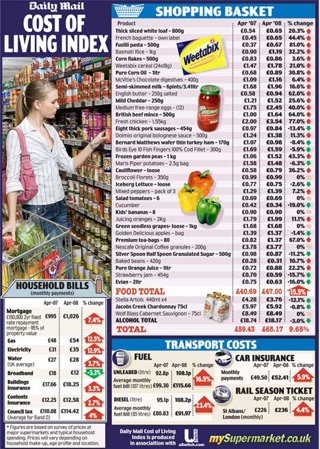
Place
Impacts of the food crisis
Egypt
Thousands of demonstrators in Mahalla el-Kobra loot shops and throw bricks at police during protests at rising food prices and low salaries. The military have been put to work baking bread.
Haiti
At least four people killed in the southern city of Les Cayes after food prices rise 50% in the past year
Côte d’Ivoire
Police injure more than 10 protesters as several hundred demonstrators demand government action to curb food prices
Cameroon
Riots last four days and result in at least 40 deaths and 1,600 arrests. Unrest is due to high fuel and food prices, with soya prices rising by 125% since last year.
Mozambique
At least four people killed and 100 injured following fuel price rises
Yemen
Five days of rioting and a hundred arrests after the price of wheat doubled over two months.
...and also in Mauritania, Bolivia, Indonesia, Mexico, India, Burkina Faso, Pakistan Senegal and Uzbekistan. World Food Programme officials say 33 countries in Asia and Africa face political instability on account of food shortages.
(Source: New Statesman, The Guardian & New York Times)
Malthus revisited
Thomas Malthus’ An Essay on the Principle of Population (1798) argued that:
-
In the absence of checks, human population can potentially grow geometrically, for instance doubling in size every 25 years
-
Production from the land can, at best, increase at an arithmetic rate, for instance climbing more slowly by the regular intervals
-
After a century, the population: food ratio could potentially reach 16:5
-
Lack of food is thus the principal check to population growth: a positive check will be brought about by famine, disease and war
-
Negative (preventive) checks can, however, be introduced as the ceiling to growth approaches (including later age of marriage or sexual abstinence)
Malthus was the first writer to recognise the importance of the ceiling to growth which may exist; he argued that there is a fixed carrying capacity for every environment.
Two Twentieth Century texts by the Club of Rome, The Limits to Growth (1972) and Beyond the Limits (1991), argued that the world was approaching a point where a Malthusian positive check to further growth seemed inevitable when viewed globally. Is the latest “food crisis” evidence that Club of Rome – and before them, Malthus – might have the correct viewpoint?
Not necessarily. First and foremost, we should remember one key fact – that more grain crops were grown worldwide last year than ever before (2.1 billion tonnes). Further increases in world population could easily be supported by existing grain yields (which are themselves still growing each year by 0.5%).
The shortages currently experienced by some societies have more complex origins than simply being a product of the number of people alive on the planet. For instance, 100 million tonnes of food will be diverted this year to feed cars as biofuel. The World Bank has recently pointed out that “the grain required to fill the tank of a sports utility vehicle with ethanol ... could feed one person for a year” (The Guardian, 15 April 2008).
Finally, the shift in Asian diets towards meat and dairy further complicates the population-resources relationship – as incomes of people, rather than just subsistence-level numbers, now need to be taken into account. Clearly, there is no shortage of factors at work in the modern world that complicate the Malthusian growth model.
A Level study tips
“Well-being = Resources ÷ Population.” Discuss.
This essay question was first asked on an A Level paper in the 1980s and is still worth giving students to tackle today - perhaps more so than ever, given the multiple complexities of the food crisis, all of which lend a perfect “synoptic” slant to the task. Critical thinking should be applied to this rather simple equation that models overpopulation “ills” according to a simple Malthusian ratio. Implicit is the assumption that social well-being – perhaps measured by the absence of famine and illness – depends upon a simple equitable division of resources.
However, as the rest of this article has shown, demands differ between income groups according to their dietary demands. Also, the political context of the biofuels debate – and the diversion of food resources to produce motor fuel for people who are already well-fed - needs to be explored.
Finally, there is scope to investigate the moral or spiritual dimension of well-being. Recent work on “the geography of happiness” could be incorporated into the essay to great effect.
Links
New Economics Foundation Happy Planet Index
BBC video on Bhutan (where the government promotes happiness)
BBC report on 2006 University of Leicester survey
UK geography teachers’ happiness project (supported by RBS-IBG)
This article is written by Dr Simon Oakes, a Principal Examiner in A Level geography for both 2008 and existing (legacy) courses.

